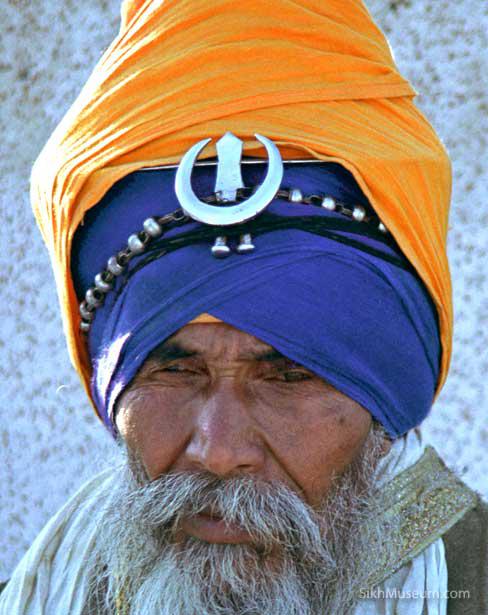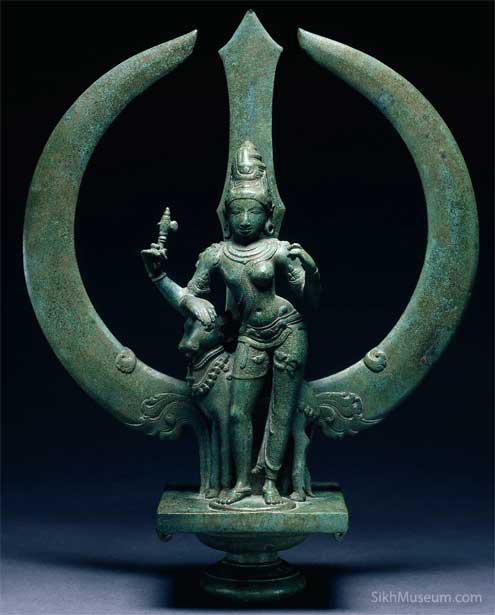- Article has extract from book, ‘The Khalsa’ and then a unique perspective on origins of Khanda and its relation with Lord Shiva.
"The emblem of Khalsa is Khanda consisting of a circle with two-edged pointed dagger in the centre and two scimitar shaped swords on both sides. The circle is symbolic of the Supreme Reality which is without a beginning and an end. It stands for enlightenment, “the perfection of humanity in unity”, as in Zen Buddhism and for the crystallization of duality into the Primal One (tai chi) as in Chinese philosophy.
The
dagger signifies the twin qualities of saint-soldier-the quality of piety and
of strength. The two swords (worn for the first time by the sixth guru, Guru Hargobind)
represent the temporal (miri) and
spiritual (piri) aspects of life.
Khanda appears on the angular, yellow or dark blue flag called the Nishan Sahib which is the insignia of victory and honour. History is replete with the heroic deeds and sacrifices of the Khalsa community in the cause of justice and fair play."
Extract
from book by Dr Satish K Kapoor, The Khalsa, Substratum, Substance and
Significance, Jalandhar, 2001, page 60.
Author is a historian, spiritualist, published
author and formerly British Council Scholar. He was Principal, Lyallpur Khalsa
College, Jalandhar and Registrar, DAV University.
To read all
articles by author
Kriyacharya Jyoti provides a historical perspective and its
connection with Siva.
Read here
or below.
The symbol of the Khanda has evolved over time and the history is sketchy. Some believe it was introduced by the sixth guru, Guru Hargobind Singh. It was added to the Nishan sahib only in the 1900’s. Earlier it only had the central double edged sword and the Chakkar/Chakra.
Later
the two swords of Miri and Piri, signifying spiritual and temporal responsibilities
were added. Practicing Sikhs also refer to the two swords as Bhakti and
Shakti.
Each
part of the Khanda had its own unique significance and now symbolic
meanings has been given to them. The Chakkar or Chakra, an ancient weapon of Bharatvarsh, was used
by the Sikh warriors. A steel throwing ring with a razor sharp edge.
Soldiers would spin it around their forefinger and throw with momentum at
their enemy maiming and wounding the enemy and their horses. It is
akin to the use of the Sudarshan
Chakra by Vishnu and Krishna.
The central
double edged sword is called the Khanda.
It originates from the Sanskrit Khand/Khadga meaning to divide and
destroy. This kind of sword is believed to have been used in India since
300 BCE, and definitely since 300 AD. Prithviraj Chauhan is credited
with improving the design, strengthening it, giving it the broad
shape that it now has to eventually make it the formidable weapon that
it became. The weapon is venerated as a symbol of Shiva and
worshipped during Dasara, Vijaydashami.
The
photographs of the Nihang warriors with the Aad
Chand, Ardha Chandra, (see pic) Shiva's moon with the double edged sword in the centre show what might be the predecessor of the present day khanda, though some sections of the Sikh’s deny it.
 Ardha Chandra worn a Nihang.
Ardha Chandra worn a Nihang.
The
Nihangs, known for their extraordinary
feats in the battlefield at the time of the Gurus, consider themselves as
an image of Shiva and call themselves Shiva Swaroop and are believed to
have originated from the Akal Sena of Guru Hargobind Singh.
The
pictures of Shiva as Ardhanarishvara
with the Trishul (pic below of shiva khanda) behind him, from
the Chola dynasty 950 AD and 1050 AD, bears an amazing resemblance to the
Khanda.
I
have always believed the Miri and Piri, the two swords that Guru Hargobind
Singh sported, as a symbol of Ardhanarishvara perfect balance between
inner and outer world. Shiva representing the spiritual and Shakti the
worldly activities.
 Shiva Khanda
Shiva Khanda
Author is into Kriya Yoga for over twenty years.
Her writings are a combination of the spiritual and reality. They have a unique perspective.
To read all
articles by author
Both
pictures courtesy http://www.sikhmuseum.com/